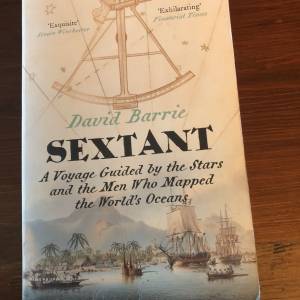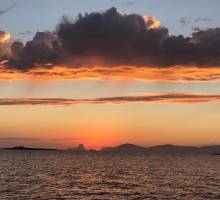
The Sextant.
I recently had the pleasure of reading David Barrie’s fabulous story of maritime exploration, entitled “Sextant”, as we cruised to and from and around the Balearics. The histories of men like Cook, Fitzroy, Anson, Flinders and Vancouver are interwoven with the history of the development of celestial navigation. The author narrates the story as he himself was engaged in a west to east transatlantic delivery of a 35 foot sailing yacht. It’s a gripping series of yarns that will keep the reader engaged for hours on end.
How fortunate we are today. GPS can give us our real time position on a moving map display. This makes navigation safer but sadly also encourages laziness. How often do we transcribe the GPS position readout onto the yacht’s logbook? I would recommend that his be an hourly chore. In case of a failure of the GPS or the yacht’s electrical system (more probable) one would at least have a last known position as a reliable starting point for “dead reckoning” navigation. Dead reckoning however is not sustainable if not supplemented with other more traditional forms of navigation i.e. bearings of coastal features or radio beacons. This may suffice inshore but offshore and out of sight of land what are we to do?
“Sextant” gave me a clue and also a chance to emulate Barrie and take some sun sights. Resolving your local noon latitude by meridian pass is easy. We practised and managed to resolve our latitude within 5’ or arc or 5nM. We thought that was not bad for amateur navigators with limited experience. Celestial navigation is fun and there is instant gratification because calculated positions can be compared with the yacht’s GPS position readout. This could provide an incentive for practice for the crew with the least accurate crew member buying a round of beers ashore!
We also tried a noon fix by meridian pass. This is a quick and dirty (but accurate enough) way to calculate latitude and longitude simultaneously as the sun reaches its zenith at your local noon position. This requires the navigator to measure the sun’s highest point in the sky whilst at the same time noting the time at which this occurs. It’s best to take a series of sights before noon noting their times and then to set the sextant to those angles as the sun starts to descend and noting those times. This will enable you to eliminate “outside data points” and average the times to determine as accurately as possible the angle and time of the meridian pass. We managed to resolve our position in the Alboran Sea to within 17.5 nM. Not very accurate you might think and certainly not a position to rely on when there is a chance of making a landfall in the dark. However, being able to find your position anywhere on the Earth to within 20nM without outside digital help is very useful.
I have resolved to get the sextant out of its box on every cruise. Practice makes perfect and much higher accuracies are possible. If you want to understand the simple principles behind celestial navigation and then learn to apply them in practice there is no better book to ready than Mary Blewitt’s now classic “Celestial Navigation for Yachtsmen”.


